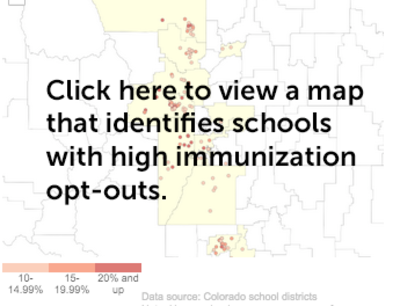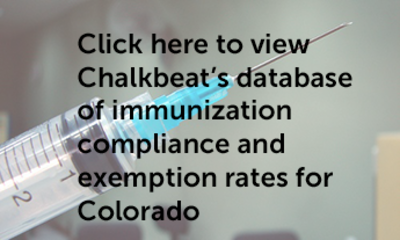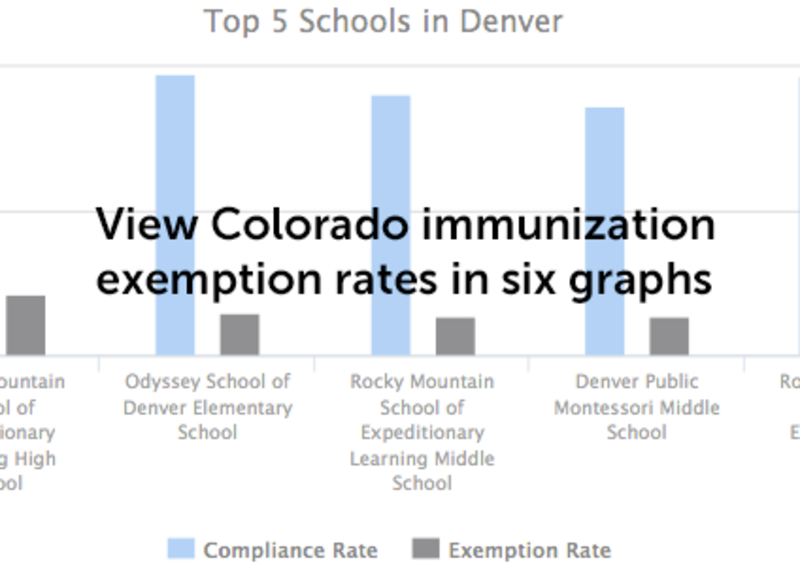When House Bill 14-1288 passed last spring, some public health advocates believed the provision requiring schools to disclose their immunization and exemption rates would affect parents’ school choice decisions.
Charles Buchanan may be proof they were right.
The Denver father was appalled to learn Tuesday that his daughter’s school—Mountain Phoenix Community School in Wheat Ridge—has an immunization compliance rate of 48 percent and an exemption rate of 37 percent.
In other words, more than half of students have submitted no immunization records at all—and may not be immunized—and most of those who have submitted records have opted out of some or all immunizations.
“It’s affecting my school choice in a big way,” he said on Tuesday evening. “My daughter won’t be going back to Mountain Phoenix Community School next year unless they come up with a different game plan.”

Buchanan said his family loves the Waldorf-inspired charter school, but added, “My daughter has medical issues where whooping cough or the measles would be more devastating than to the average kid.”
With what’s referred to as “herd immunity” usually requiring immunization rates of 90-95 percent, it’s clear that Mountain Phoenix wouldn’t even come close to that threshold. Without that group protection, its easier for communicable diseases to spread, even sometimes to people who have been fully vaccinated, like Buchanan’s third-grade daughter,
Mountain Phoenix was among more than 1,000 schools included in Chalkbeat Colorado’s new database showing immunization compliance and exemption rates in the state’s 20 largest districts. Currently, the data is not compiled by any state agency or available in aggregate form anywhere else.
For many observers, it’s no surprise that certain charter schools and other schools with alternative philosophies tend to have higher exemption rates and lower compliance rates.
“I do know that charters may attract different types of parents. The data does show that non-immunizing parents tend to cluster geographically… and they probably tend to cluster around school philosophies as well,” said Stephanie Wasserman, executive director of the Colorado Children’s Immunization Coalition.
Dr. Simon Hambidge, Chief Ambulatory Care Officer and co-chair of the immunization committee at Denver Health noted that many vaccine-hesitant parents are white, upper-middle class, college-educated women. He didn’t think he’d be surprised by the schools where lots of parents opt out of immunizations.
“I can guess which ones may have higher [exemption] rates.”
The start of something
While schools have long collected documents demonstrating that students either had all the required shots or were officially excused from shots by their parents, the mandate to publicly disclose those numbers is new. And while most experts believe this new level of transparency will have positive impacts on public health, they say some schools may have to change procedures to better comply.

“Districts are going to have be a little more on top of things,” said Kathleen Patrick, assistant director of health and wellness at the Colorado Department of Education or CDE. “It’s going to be a little bit of a growing pain for schools.”
Public health advocates were disappointed in the final version of HB 14-1288 because it stripped a key provision that would have made it harder for parents to claim “personal belief exemptions” from some or all vaccinations. Still, advocates see it as a first volley in a long-term push for stronger immunization laws and policies in the state.
“It’s an incremental success,” said Wasserman. “We want to be able to revisit to see whats working, what’s not working. Do we need to attach a fiscal note or some funding?”
So far, the short-term effects of the law, particularly the public disclosure of immunization rates—coming during a national measles outbreak—have garnered praise.
“I think it is always good to put meaningful data into the hands of people to whom it is important. And this is important to parents,” said Hambidge.
Besides factoring into school choice decisions, worrisome immunization and exemption rates also present an opportunity for parents to become immunization advocates within their schools, said Wasserman.
“It would be a great tool to advocate among school leadership and peers to have some kind of parent event where someone from my organization or someone from the state can talk about why choosing to exempt your child…puts your own school community at risk,” she said.
It’s a role that Buchanan took on in small way on Tuesday when he phoned both the school nurse and the operations manager at Mountain Phoenix to discuss his concerns. He said the operations manager reported that school staff will meet to develop a plan to increase compliance rates.
“That’s a good thing because the legislation was intended to make this information publicly available so there would be pressure on these schools to up their compliance,” said Buchanan. “Its proof that the law is working and hopefully having some effect.”
What’s next
While some schools and districts may now be scrambling to up compliance rates and decrease exemption rates, the state’s health decision-makers are hatching longer-term plans that might someday mean the creation of a public database with immunization rates and exemption rates for all Colorado schools and child care providers. Patrick said that probably won’t happen from within a state agency without additional legislation. Wasserman said she’s been talking with funders about such a project, which is one of her organization’s key goals.

In the meantime, officials from various state departments and organization are discussing ways to streamline the paper chase that can hamper overburdened school nurses in their pursuit of immunization paperwork. Patrick said officials have talked about allowing parents to submit exemption forms electronically, though such a streamlined process is probably farther away for immunization forms because of privacy issues.
CDE officials have also talked about leveling out the playing field when it comes to disclosure of immunization and exemption rates by recommending a set date that rates be compiled. Currently, there are no requirements about when rates must be compiled. Among the 20 districts that provided data to Chalkbeat, collection dates ranged from May 1, 2014 for the Thompson School District, which achieved near-perfect compliance-to February 2015 for a number of other districts.
And while the gears of policy-making grind on, health care providers still see plenty of parents who worry about the safety of vaccines.
Hambidge said it’s important to remember that 90 percent of parents who claim personal belief exemptions, the most commonly used exemption in Colorado, get at least some required vaccinations for their children. Typical concerns, he said, tend to be about the discredited notions that the MMR vaccine, which stands for Measles Mumps Rubella, is linked to autism, or that the number of shots required for one-year-olds “overwhelm their systems.”
“Most impactful, because we’re having the most serious measles outbreak that we’ve had since the 1990s, is the autism fear,” he said. “I think it’s important to acknowledge their fears. They are trying to do what’s in the best interest of their children” he said.
“It’s really important to continue the conversation.”
Explore this map by hovering your cursor over dots to see school names and exemption rates. The map highlights the more than 140 Colorado schools in the state’s 20 largest districts that have enough students opting out of immunizations to potentially compromise herd immunity and hasten the spread of communicable diseases.
Use Chalkbeat’s database to look up immunization compliance and exemption rates for individual schools in the 20 largest districts in the state. These districts enroll around three-quarters of the state’s students. Visit this page to learn more about the database’s terminology and how we compiled the data.

